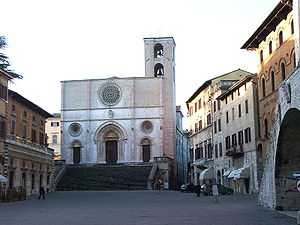Diocese of Todi

Cathedral of Todi
The Italian Catholic diocese of Todi existed until 1986, when it was united into the diocese of Orvieto-Todi.[1] It was directly dependent on the Holy See.
History
During the Gothic War the city of Todi withstood Totila during a long and severe siege. The Lombard failed to capture it, and Todi and Perugia remained the two chief fortresses defending the passage through the duchy from Rome to the Exarchate. It was included in Pepin's donation to the Holy See.
St. Terentius, or Terentianus, was martyred under Diocletian. Other bishops are:
- St. Callistus, killed by the Goths
- St. Fortunatus of Todi
- Theophylactus of Todi (787), sent by Pope Adrian to England and to the Council of Frankfurt (794);
- Rustico Brancaleone (1179), several times a papal legate;
- Rainuccio degli Atti (1326), expelled from the city by the partisans of antipope Nicolas V;
- Andrea degli Atti (1356), the restorer of ecclesiastical discipline;
- Guglielmo Dallavigna (1405), who tried to induce the antipope Benedict XIII to renounce his claim;
- Bartolomeo Aglioni (1436), imprisoned during the troublesome times;
- Marcello Sante (1606), who erected the seminary;
- Carpegno (1638) who promoted study and discipline;
- Cardinal Ulderico;
- Cardinal Giambattista Altieri (1643), brother of Pope Clement X, a famous canonist;
- the brothers Cardinal Filippo Antonio Gualterio (1709) and Ludovico Anselmo Gualterio (1719), who erected a new seminary;
- Francesco M. Pasini (1760), under whom the restoration of the cathedral was completed.
Notes
External links
![]() This article incorporates text from a publication now in the public domain: Herbermann, Charles, ed. (1913). Catholic Encyclopedia. Robert Appleton Company.
This article incorporates text from a publication now in the public domain: Herbermann, Charles, ed. (1913). Catholic Encyclopedia. Robert Appleton Company.